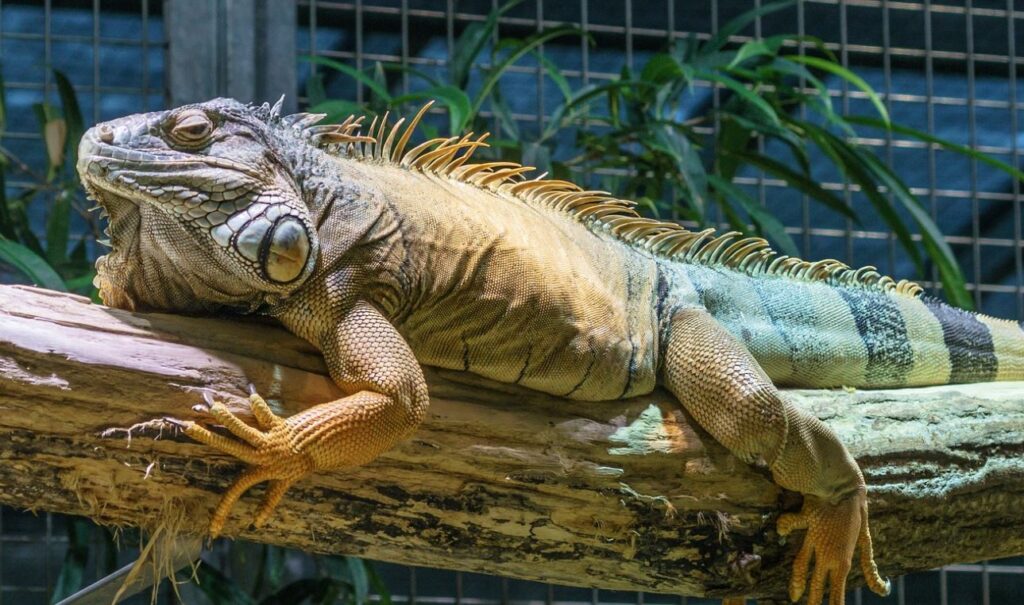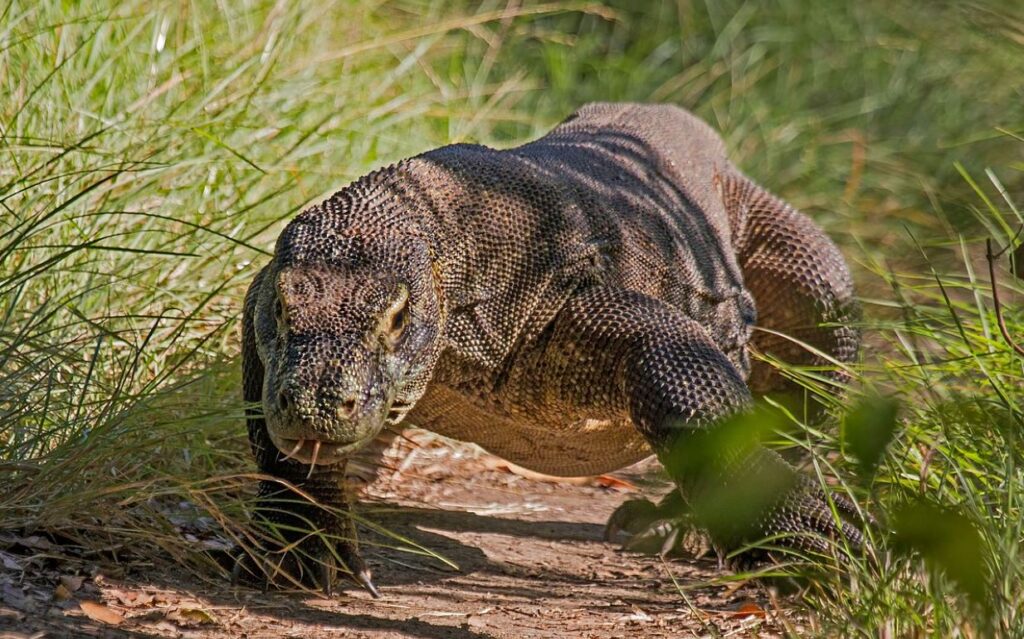Differences Between Komodo Dragons and Iguanas
Komodo dragons and iguanas are both reptiles, but honestly, that’s about as far as the similarities go. But what about the differences? There are plenty of differences between these two animals to make sure that you can always tell them apart, which is just as well as you really wouldn’t want to mistake a komodo dragon for an iguana accidentally!
How to tell Komodo Dragons and Iguanas Apart
1. Size
One of the most tell-tale differences between a komodo dragon and an iguana is the vast difference in their sizes. Komodo dragons can grow to be a whopping 10 feet long and average 80-90kg, although some have weighed far more. In complete contrast, iguanas can grow to be around 5 feet long but only weigh around 4kgs – a fraction of the size of a komodo dragon.
2. Colour
Not only is size a significant difference between the two, but the color of a komodo dragon and an iguana makes them very easy to tell apart. A komodo dragon is usually black, but some appear to be yellowish-gray, while iguanas are bright and vibrant.

Most iguanas are green, but they can vary between yellow, turquoise blue, light grey, and orange. Iguanas also often appear to be much darker when cold, especially when they are dangerously cold and need to warm up immediately to survive.

3. Venom
Honestly, it’s far better if you never get close enough to a komodo dragon to find out for yourself just how different their venom is to that of an iguana. Still, there is a massive difference between the two – one is deadly, and one is not. An iguana produces a mild venom that doesn’t do any harm, while a komodo dragon’s a killer.
It was originally thought that it was the bacteria in the deadly venom. However, it is now known that it is the venom itself that does the damage. The venom produced by a komodo dragon causes the blood pressure of its prey to drop, and it also prevents the blood from clotting. This then causes massive blood loss from the wounds inflicted by the bite, and death will eventually follow.
4. Location & habitat
Komodo Island is, as the name suggests, a place that is heavily populated with komodo dragons. Iguanas are widespread across the Caribbean, Mexico, Brazil, and Central America. Komodo dragons are found mainly on the Lesser Sunda Islands of Indonesia and usually live in tropical forests. Their preferred habitat is in the rainforests, where they spend a lot of their time in the trees.
5. Food
Iguanas are herbivores and prefer to eat leaves but will occasionally eat flowers as well. The diet of a komodo dragon couldn’t be more different than that of an iguana as they are carnivores and are fierce hunters who frequently kill animals much bigger than themselves. They will eat any kind of meat – from livestock to water buffalo to other Komodo dragons.
6. Spines
As well as their size and color, iguanas and komodo dragons are much different in their appearance too. Iguanas have spines on their back and tail, which are believed to defend against predators. The proper name for the spikes is scutes, and they are thought to be used to scare away predators. Komodo dragons do not have any spines on their backs, but their scales are thick and leathery.
7. Throat
Iguanas have a distinctive flap of skin – similar to a pouch – underneath their throats. This is called a dewlap and is used as a method of communication. When an iguana is being territorial and defending itself, it will “puff” the dewlap out. This is to make them look bigger and more threatening. Male iguanas also use it to attract females as they puff their dewlaps out to show off to the females in the hope of attracting them as a mate. Komodo dragons do not have a dewlap.
8. Speed
Unless you can run pretty fast, you don’t want to get chased by a komodo dragon as they can run at around 12-13mph, which doesn’t give you much time to get away from it. On the contrary, iguanas are pretty friendly and certainly don’t move that fast.
9. Tail
Did you know that iguanas can regrow their tails? If their tail breaks off between the vertebrates in it, then it can grow back. However, their new tail is usually thinner than the old one and a darker color. Komodo dragons are unable to do this. Instead, they have an extremely thick and powerful tail that they often use to sweep their prey off their feet with.
10. Temperament
Iguanas and Komodo dragons have vastly different temperaments. Iguanas are relatively docile animals that can be tamed and often make good pets. Komodo dragons are extremely vicious and use their teeth, claws, venom, and tail to protect themselves.
11. Skin
Iguanas often shed their skin a couple of times a year, and it comes off in large patches rather than one complete piece. A komodo dragon has very thick and leathery skin, and they only shed theirs in small patches.
Questions & Answers
Answer: No, they are both reptiles, but they are not related as they come from different family groups. Komodo dragons are from the family group Varanida while iguanas are from the group Iguanidae.
Question: Can Komodo dragons and iguanas mate?
Answer: No. There is a massive difference in the size of the two animals, and a komodo dragon would just see an iguana as prey.
Question: Is a komodo dragon dangerous?
Answer: Yes, komodo dragons are extremely dangerous. They have a large and lethal bite with teeth very similar to those of a shark and produce a deadly venom that kills by lowering the blood pressure and preventing blood from clotting, which causes extreme blood loss and shock. If the bite alone didn’t kill you, then the venom and blood loss would kill you within a few hours.
Question: Can a komodo dragon kill you?
Answer: Yes, a komodo dragon is a lethal hunter that would easily kill a human if you got in its way.
Question: Do iguanas make good pets?
Answer: Yes, they can be tamed relatively easily and are known to be affectionate animals that make good pets.
Question: What do komodo dragons eat?
Answer: Komodo dragons are carnivores and regularly kill and eat large animals such as deer, pigs, water buffalo, and livestock such as sheep and cows.
Question: Are iguanas carnivores?
Answer: No, iguanas are herbivores and generally eat the leaves from trees.
Question: Can iguanas swim?
Answer: Yes, iguanas are excellent swimmers and often live near water.
Question: How big can komodo dragons get?
Answer: Komodo dragons regularly grow to be around 10 feet in length and weigh over 90kgs.
Question: Do you need a heat lamp if you have an iguana as a pet?
Answer: Yes, if you have a pet iguana, then you should have a heat lamp or some other form of keeping its living area heated. Iguanas are cold-blooded, which means that they cannot maintain their body temperature in a cold environment. Iguanas will become sluggish when they are becoming too cold and can appear to be dead.
Question: Do iguanas have teeth?
Answer: Yes, iguanas have between 20 and 30 teeth, and they are mostly all serrated.
Question: Are iguanas dangerous?
Answer: On the whole, iguanas are not dangerous to people. They do have sharp teeth, so they can occasionally bite, but it is not usually severe, and although they do produce venom, it is weak and relatively harmless.
Question: Has anyone ever been killed by a komodo dragon?
Answer: Yes, although the actual death rate is relatively low, wild and captive Komodo dragons have killed people.
Question: Does a komodo dragon have any predators?
Answer: No, as komodo dragons are the main predator in the area where they live, they have no natural predators of their own to worry about.
Question: Do iguanas have any predators?
Answer: Yes, iguanas have several predators, such as raccoons, snakes, owls, hawks, and dogs.
Question: Why do iguanas have a pouch under their throat?
Answer: The pouch is called a dewlap and is used to warn off other iguanas from their patch and is also used by males to attract females.
Question: Are Komodo dragons solitary animals?
Answer: Yes, the komodo dragons are solitary animals that spend most of their lives alone. They are usually only found together when they are mating and occasionally when they are eating.
Question: Are iguanas solitary animals?
Answer: No, iguanas are often found in groups as they are very social animals.
Question: How long do Komodo dragons live for?
Answer: Komodo dragons often live for around 30 years.
Question: Are Komodo dragons and iguanas endangered?
Answer: Yes, komodo dragons are officially classed as vulnerable as their numbers are declining due to the people poaching the deer, which are the main source of food for them, and also due to the destruction of their natural habitat by people. Iguanas are also endangered due to the destruction of their habitat.

